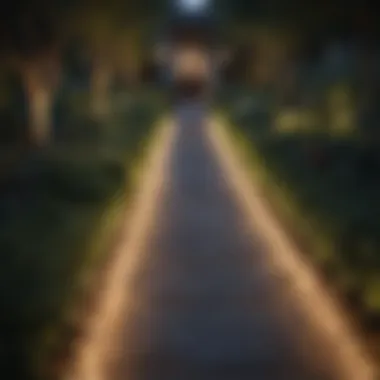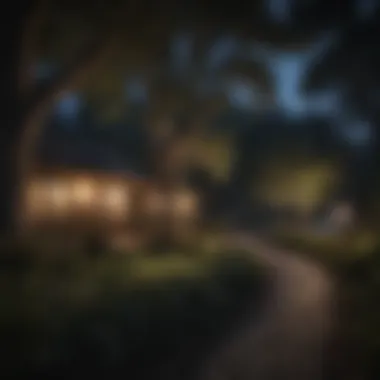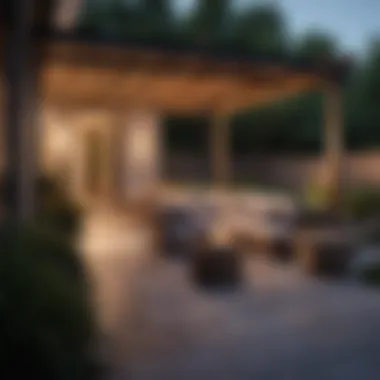Landscape Lighting Tips for Aesthetic Appeal and Utility


Intro
Creating an inviting and functional outdoor space requires more than just the right plants and decor. Landscape lighting plays a pivotal role in enhancing aesthetics while providing safety and utility. Understanding how to balance these elements can elevate the overall experience in your outdoor area.
In this guide, we will explore critical aspects such as design considerations and types of lighting that can transform your garden into an enchanting space. We will touch on various installation techniques and essential maintenance practices to ensure your outdoor lighting remains effective over time.
Our aim is to impart knowledge that enables homeowners and design enthusiasts to not only beautify their outdoor environments but also make them practical and safe for use at any time of day. Let us delve into effective landscape lighting strategies that marry beauty and function.
Preface to Landscape Lighting
In the context of outdoor spaces, landscape lighting serves as a vital component that merges beauty with function. Properly designed lighting not only elevates the visual appeal of gardens and yards but also enhances safety and usability during nighttime. Homeowners and gardening enthusiasts must consider how light can define spaces, emphasize features, and create an inviting atmosphere.
Understanding the Role of Lighting
Lighting performs a key role in landscape design. It helps to showcase architectural elements, guide paths, and create visual interest. Well-placed light fixtures can draw attention to lovely flowers, interesting trees, or ornamental features in the landscape. More importantly, lighting can illuminate pathways and entrances, making outdoor areas safer for evening activities.
Various types of lighting exist, each serving distinct purposes. Uplighting can accentuate the height of trees or structures, while downlighting can provide a soft glow that mimics natural moonlight. Meanwhile, pathway lighting offers practical benefit by illuminating walkways, ensuring safe navigation through the landscape at night.
Proper landscape lighting integrates aesthetic appeal with safety, making it essential in comprehensive garden design. Homeowners should approach lighting as part of their overall landscape strategy.
Benefits of Landscape Lighting
Implementing landscape lighting offers numerous benefits:
- Aesthetic Appeal: Enhances the visual beauty of gardens and outdoor spaces. A well-lit area can transform even simple landscapes into elegant settings.
- Safety and Security: Illuminated pathways and steps reduce the risk of accidents and enhance security by deterring potential intruders.
- Extended Usability: Lighting allows homeowners to enjoy their outdoor spaces after dark, facilitating social gatherings, evening relaxation, or outdoor activities.
- Highlight Focal Points: It helps accentuate specific features, such as sculptures, water fountains, or architectural elements, creating focal points that engage viewers.
By understanding the importance of landscape lighting, homeowners can make informed decisions that elevate both the functional and aesthetic aspects of their outdoor environments.
"Lighting not only serves a practical purpose; it transforms spaces and mood, creating an ambiance that resonates with the user."
Overall, the right landscape lighting strategies allow for a seamless transition from day to night, enriching the outdoor experience.
Types of Landscape Lighting
Understanding the variety of landscape lighting is essential in achieving both aesthetic appeal and functionality. Each type serves a unique purpose, and their correct application can remarkably transform an outdoor space. Landscape lighting enhances safety by illuminating pathways, accentuates design features, and fosters an inviting atmosphere during nighttime. By familiarizing oneself with the different types of lighting available, homeowners can make informed choices that align with their specific needs and decor style.
Pathway Lighting
Pathway lighting is a critical element for safety and guidance in outdoor spaces. It typically involves the installation of fixtures along walkways, driveways, and garden paths. The purpose is not only to illuminate the path but also to create a welcoming ambiance.
When selecting pathway lights, consider the height and brightness of the fixtures. Shorter lights tend to create a softer glow, while taller options offer increased visibility. LED bulbs are often recommended due to their energy efficiency and longevity. Uniform placement is crucial; lights should be spaced evenly to avoid dark spots and ensure people can navigate safely.
Accent Lighting
Accent lighting is designed to highlight specific features in the landscape. This could be a beautiful tree, sculpture, or the architectural details of your home. The goal is to create points of interest that draw the eye and enhance the overall aesthetic.
Focal points are created using directional lights. Spotlights or well lights can be effective for this type of application. Consider the angle and intensity of the light when positioning, as it significantly impacts the effect. Using warm bulbs often results in a more inviting feel.
Uplighting
Uplighting involves placing lights at ground level to illuminate vertical features from below. This technique can significantly enhance the visual drama of outdoor spaces. Uplighting is commonly used for trees, tall plants, and structures, emphasizing their shape and texture.


The proximity of fixtures to the subjects is important to avoid overpowering the landscape. Dimmers can allow for adjustable brightness, ensuring the lighting can adapt to different settings. This method can create dramatic shadows, adding depth and intrigue.
Downlighting
Downlighting is the opposite of uplighting, with fixtures mounted above the area to cast light downward. It mimics natural light and can create a sense of openness in larger outdoor spaces. This technique is often accomplished using overhead fixtures hung from trees or eaves.
Selection of the light source is key for downlighting. Soft-white bulbs can create a gentle glow, enhancing the natural environment. Downlighting is particularly effective for illuminating seating areas or outdoor kitchens, contributing both additional safety and ambiance.
Moonlighting
Moonlighting offers a unique approach that provides soft, diffused illumination, mimicking natural moonlight. This effect is usually achieved by placing fixtures high in trees or structures and angling them downward.
Using low wattage bulbs ensures the effect is subtle enough to evoke a serene environment. This lighting technique is excellent for creating a relaxing atmosphere in gardens, patios, or around pools, effectively enhancing nighttime gatherings without harsh glare.
Spotlights and Floodlights
Spotlights and floodlights serve distinct functions in illumination. Spotlights focus on a particular point or feature, providing concentrated light, while floodlights cast a wider beam, illuminating larger areas.
For security purposes, floodlights are often used around home perimeters. However, they can also contribute to aesthetic arrangements when used strategically. Spotlights, on the other hand, are ideal for accentuating architectural details or landscape features. Proper placement and angle adjustments can maximize their effectiveness for both security and aesthetics.
The right combination of lighting types not only enhances safety and visibility but also elevates the aesthetic appeal of any outdoor space.
Understanding these various types of landscape lighting ensures that homeowners can create the right atmosphere while maintaining functionality. Through careful planning and consideration, it’s possible to achieve a well-lit, beautiful outdoor environment.
Design Considerations for Landscape Lighting
Designing a landscape lighting plan is crucial for both aesthetic appeal and functional use. A well-thought-out approach ensures that the outdoor environment not only looks inviting but also remains safe and usable after sunset. In this section, we will explore key elements of this process, emphasizing how thoughtful design can significantly enhance the overall ambiance and usability of outdoor spaces.
Establishing a Lighting Plan
Establishing a lighting plan forms the bedrock of effective landscape lighting. This step involves assessing the specific needs of the area to be illuminated. Consider the layout of paths, gardens, and architectural features. Begin by identifying which areas require illumination and what the primary purpose is—whether to enhance safety, highlight focal points, or provide general ambiance.
- Outdoor pathways: Ensure adequate lighting for safety without overwhelming brightness that can disturb nocturnal wildlife. - Entrances and exits: Illuminate these spaces sufficiently to create secure transitions into and out of your property. - Seating areas: Use light to create intimacy while ensuring enough visibility.
Thoughtful assessment leads directly to a better understanding of what types of lights to choose and how they should be laid out.
Focal Points and Visual Interest
Focal points are significant in landscape design. Using lighting to draw attention to specific features can transform the space. These can be anything from a beautiful tree to a sculpture or water feature. Properly placed lights create a sense of depth and interest.
It is important to:
- Highlight key elements: Use accent lighting to illuminate trees, gardens, or architectural details, making them stand out.
- Create depth with contrast: Combine different intensities and angles of light to enhance textures and colors.
- Integrate with landscaping: Ensure the lighting complements natural elements rather than overpowering them.
Focal points invite viewers to explore the space and appreciate the details hidden in the shadows.
Creating Atmosphere with Lighting
Lighting not only serves practical purposes but also plays a vital role in setting the mood of an outdoor space. The right lighting can create various atmospheres—tranquil, romantic, or vibrant—depending on how it is employed.
Focus on these elements:


- Warm tones: Utilize warm-colored lights to create a welcoming environment.
- Layered lighting: Employ a mix of ambient, task, and accent lighting to create a rich, multi-dimensional effect.
- Dimmer switches: Consider these for added versatility, allowing adjustment based on occasion or time of day.
Ambiance shaped by landscape lighting informs the way spaces are used. Thoughtful choices facilitate gatherings, quiet moments, or bright celebrations depending on desired experiences.
A well-planned lighting design not only enhances functionality but adds immense value and beauty to outdoor spaces.
Incorporating these considerations into your landscape lighting strategy can have profound impacts on your outdoor areas. It is not just about visibility; it is about creating an experiential environment that elevates the beauty and accessibility of your garden or yard.
Installation Techniques
The installation of landscape lighting is a fundamental aspect of achieving the intended aesthetic and practical outcomes in outdoor spaces. Proper installation not only enhances the visual appeal of a property but also ensures safety and durability. Adequate planning during the installation process can prevent future issues, such as malfunctioning lights or electrical hazards. This section will explore the essential tools and equipment, wiring basics, and placement and spacing guidelines that are crucial for effective landscape lighting installation.
Tools and Equipment Required
When preparing for landscape lighting installation, having the right tools and equipment is crucial. Here are some of the most commonly needed items:
- Low Voltage Transformer: Converts standard voltage to low voltage, essential for safety.
- Wire Strippers: For preparing the wires, ensuring a secure connection.
- Shovel or Digging Bar: Useful for burying wires.
- Voltage Tester: Ensures the electrical circuits are safe and functioning correctly.
- Ladder: Needed for reaching elevated fixtures.
- Drill: For installing fixtures into hard surfaces like stone or concrete.
- Level: Ensures lights are installed at the correct angle and position.
Having these tools ready can simplify the installation process and lead to better results.
Wiring Basics
Understanding the basics of wiring is vital for safe and effective landscape lighting installation. Here are some important points to keep in mind:
- Low Voltage Wiring: Most landscape lights use low voltage, typically 12 volts. This reduces electrical hazards and allows for easier installation.
- Wire Gauge: Use the correct wire gauge to prevent overheating. Generally, 12 or 14 gauge wire is suitable for landscape lighting.
- Cable Length: Longer distances may require thicker wires to minimize voltage drop. Assess the distance from the transformer to the fixtures to determine the correct gauge.
- Connection Types: Using weatherproof connectors is necessary to protect against moisture and corrosion.
- Circuit Configuration: Plan the wiring layout. Connecting fixtures in parallel ensures that if one light fails, the others will continue to function.
Placement and Spacing Guidelines
Correct placement and spacing of lights are crucial for achieving the desired effect in landscape lighting. Here are key considerations:
- Height and Angle: Install fixtures at a height that best showcases plants or features. For instance, uplighting can be more effective when light sources are placed lower and pointed upwards.
- Distance Between Lights: Generally, space fixtures about 10 to 15 feet apart. This reduces overlap and creates a balanced look.
- Focus on Features: Align lighting with specific features, such as trees, pathways, or architectural elements. This enhances focal points while providing a functional light.
- Test Before Finalizing: It is beneficial to temporarily set up the lights to evaluate their effectiveness before final installation. Adjust angles and placements based on how the light plays on the landscape.
"Proper installation techniques significantly influence the longevity and aesthetics of landscape lighting."
By adhering to these installation techniques, homeowners can foster an inviting and well-lit outdoor space that enhances both functionality and beauty.
Energy-Efficient Lighting Options
Energy-efficient lighting options are crucial for modern landscape design. They address multiple concerns ranging from environmental impact to long-term cost savings. By integrating these options, homeowners can enjoy aesthetically pleasing outdoor spaces while reducing energy consumption. This balance between beauty and functionality is of paramount importance in any landscape lighting strategy.
LED Lighting
LED lighting has gained significant popularity due to its efficiency and versatility. One of the primary advantages of LED lights is their long lifespan. Unlike traditional incandescent bulbs, LED lights can last up to 25 times longer. This means less frequent replacements and reduced waste. Additionally, LEDs are much more energy-efficient, using at least 75% less energy compared to incandescent bulbs.
Furthermore, they produce less heat, which is a valuable feature for outdoor lighting. Lower heat generation minimizes the risk of fire hazards, making them safer for gardens.
In terms of design, LEDs come in various colors and brightness levels. This versatility allows homeowners to customize their lighting schemes according to their specific needs. From soft, ambient lighting to bright task lighting for pathways, LEDs can fulfill diverse requirements.
Another benefit is their ability to work with smart home technology. Homeowners can control LED lighting systems remotely, adjusting brightness and colors to match their preferences.
Solar-Powered Solutions


Solar-powered lighting is another outstanding option for energy efficiency in landscape design. These lights utilize solar panels to convert sunlight into electricity, making them environmentally friendly. During the day, they absorb sunlight and store energy in built-in batteries, which then powers the lights at night. This feature significantly reduces electricity bills since they do not rely on traditional power sources.
Moreover, solar-powered lights are easy to install. There is no need for extensive wiring, which can be both cumbersome and costly. Homeowners can place these fixtures anywhere sunlight reaches, adding more flexibility to their design choices.
However, it is worth noting that their performance can be affected by weather conditions. On cloudy days, solar lights may not charge sufficiently, leading to reduced brightness. Therefore, selecting high-quality products with efficient solar cells is essential for optimal performance.
"Integrating energy-efficient solutions not only beautifies outdoor spaces but also contributes to sustainability."
This approach allows for an outdoor environment that is not only visually appealing but also responsible and economical.
Maintenance and Upkeep
Maintaining landscape lighting is crucial for ensuring both aesthetic appeal and functionality. Over time, outdoor lighting fixtures can become dirty or damaged, which can significantly diminish their visual impact. Routine maintenance prevents small issues from escalating into costly repairs. Moreover, proper upkeep ensures that fixtures operate as intended, contributing to the safety and ambiance of outdoor spaces.
A well-maintained lighting system not only enhances the beauty of the garden but also extends the life of the equipment, reducing replacement costs. By implementing systematic maintenance practices, homeowners can achieve an enduring aesthetic value in their outdoor environments.
Regular Cleaning and Inspection
Regular cleaning is a primary aspect of maintenance for outdoor lights. Dirt, dust, and other debris can obscure light sources, reducing effectiveness. It is advisable to clean fixtures every few months, or more frequently in areas with bad weather. A gentle solution of soap and water is often sufficient for most surfaces, but care should be taken to follow manufacturer guidelines for specific materials.
During these cleaning sessions, it is also important to check for wear and tear. Look for signs such as rust on metal fixtures or cracks in plastic components. Early detection can prevent more significant issues down the line.
- Check the bulbs: Make sure they are functioning correctly and replace any that are burnt out.
- Inspect the wiring: Look for any exposed or damaged wires that could present safety hazards.
Troubleshooting Common Issues
Even with routine maintenance, issues may arise in landscape lighting systems. Understanding basic troubleshooting can save time and resources. Here are common problems and solutions:
- Low Light Output: This could be due to dirty fixtures or a failing bulb. First, clean the light and replace the bulb if necessary.
- Flickering Lights: This might be caused by poor connections. Check all wiring connections for tightness.
- Complete Failure: If a light isn't working, check the power source. If the circuit breaker is tripped, it may need resetting.
- Sensor Issues: If using lights with motion sensors, ensure that obstructions are not blocking the sensor's field of view.
"A little knowledge in troubleshooting can often save a lot of headaches and money in repairs."
Seasonal Adjustments
Seasonal adjustments to lighting can significantly enhance outdoor spaces throughout the year. Different seasons bring varying needs for lighting aesthetics and functionality. Here are some considerations:
- Summer: Use brighter lights for longer evenings to illuminate pathways and recreational areas. Check if fixtures need repositioning due to foliage growth.
- Fall: Adjust lighting to highlight autumn colors. Reducing brightness can create a cozy atmosphere as days get shorter.
- Winter: It might be necessary to reposition lights for holiday decorations or to deal with snow accumulation. Ensure all fixtures are clear from snow and functional before holiday gatherings.
- Spring: After winter, check for any damage from weather conditions. Reset timers and adjust light levels to accommodate longer days.
Adjusting lighting to complement seasonal changes not only improves visual interest but also adds functionality to the outdoor spaces, making it more inviting throughout the year.
The End
Landscape lighting is more than just a practical necessity for any outdoor space; it serves as a vital component that enhances aesthetics while providing safety and security. The design and implementation of effective lighting can drastically change how we perceive and experience our gardens and outdoor areas. It is crucial to understand that each type of lighting offers unique benefits and applications, making it essential to explore options thoroughly.
Even as we enjoy outside spaces during the day, darkness can shroud their beauty. Thus, carefully selected landscape lighting can reveal the architectural features of your home, highlight garden elements, and create an inviting atmosphere during nighttime. This is especially important for homeowners looking to host evening gatherings or simply enjoy their surroundings after sunset.
Beyond visual appeal, maintaining safety is a paramount benefit of landscape lighting. Well-lit pathways, steps, and entrances reduce the risk of accidents and deter potential intruders. In this way, strategic placement and the right intensity of lighting contribute significantly to a sense of security. This aspect is particularly relevant for homeowners who may have young children or entertain guests frequently.
Moreover, energy-efficient options, like LED or solar-powered lighting solutions, can satisfy aesthetic desires without inflating energy bills. Integration of these technologies is easier now, making it more accessible for everyone. Ultimately, a well-planned landscape lighting arrangement beautifully harmonizes practicality with style.
Recap of Key Points
- Importance of Lighting: Enhances beauty and safety outdoor.
- Types of Lighting: Different types serve specific functions and effects.
- Design Considerations: Planning is essential for both aesthetics and practicality.
- Maintenance: Regular upkeep is crucial for optimal functionality.
Final Thoughts on Landscape Lighting
Landscape lighting represents a blend of functionality and art. Each choice made in designing and implementing outdoor lighting can reflect personal style while addressing safety needs. As homeowners invest time and resources to achieve a captivating outdoor space, it's essential to consider not just the initial setup but also how that setup performs over time.
With the insights provided throughout the article, readers should now feel equipped to make informed decisions concerning their landscaping needs. Whether the goal is to entertain guests, create a relaxing retreat, or ensure safety, the key lies in precisely identifying needs and applying the appropriate techniques. In this journey, maintaining a balance between aesthetics and functionality remains a constant goal.







